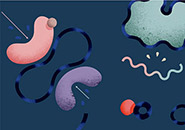French Settlement, Louisiana, is an unassuming little town just northwest of New Orleans. It is also the place where a group of genetic disorders known as hereditary spastic paraplegia (HSP), or French Settlement Disease, was first discovered. Unlike the town, the disease is anything but modest: its main features are stiffness and involuntary contractions in the legs. Thirty-five years after the disease’s discovery, a study led by HHMI Investigator Joseph Gleeson at the University of California, San Diego, has almost doubled the number of genes associated with HSP.
Scientists had already linked 22 genes to HSP, but mutations in those genes explained less than 50 percent of the cases. To find more genes, Gleeson and a team of 51 scientists from around the world recruited 55 families with HSP. The scientists sequenced every gene in 93 family members and discovered 18 genes newly linked to the disease. They then created an “HSPome”—a genetic map showing how all the HSP-associated genes interact with each other.
The effort, which took 10 years, allowed the researchers to link HSP to other common neurodegenerative diseases, such as Alzheimer’s. “This told us that common neurodegenerative diseases share similar networks and cellular vulnerabilities,” says Gleeson. “Maybe we need to think about these less as individual diseases and more as collective problems of neuronal susceptibility.”
The findings, reported January 31, 2014, in Science, may help Gleeson and his colleagues develop new treatments for HSP. They’re already pursuing several promising targets.







